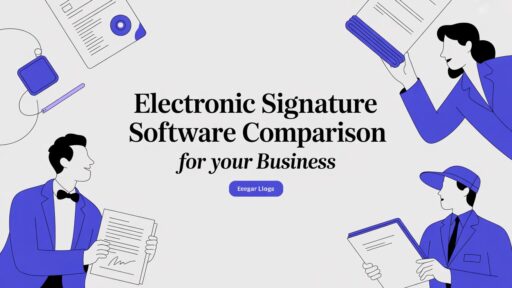In today’s digital age, electronic signatures have become an essential tool for the insurance industry. By harnessing the power of technology, insurers can streamline document signing processes, enhance client experience, improve efficiency, and ensure security and compliance. When selecting an electronic signature solution, insurance companies need to consider factors such as security, compliance, user-friendliness, and mobility options. Here are some key points to keep in mind regarding electronic signatures in the insurance industry.
Essential Factors to Consider When Selecting an Electronic Signature Solution for Insurance
Prioritizing Security in Electronic Signatures
Security is paramount when it comes to electronic signatures in the insurance industry. Look for solutions that offer robust encryption, secure storage, and authentication measures. Ensure that the solution complies with relevant security standards and has undergone independent security audits.

When it comes to sensitive insurance documents, such as policy agreements and claims forms, maintaining the highest level of security is of utmost importance. A reputable electronic signature solution should employ advanced encryption algorithms to protect the integrity and confidentiality of your data. Additionally, secure storage ensures that your signed documents are stored in a protected environment, safeguarding them from unauthorized access or tampering.
Authentication measures are also crucial in ensuring the validity of electronic signatures. Look for solutions that offer multi-factor authentication, such as biometric verification or one-time passwords, to add an extra layer of security. By implementing these measures, you can have peace of mind knowing that your electronic signatures are protected against any potential threats.
Ensuring Compliance with Industry Regulations
Compliance with industry regulations is crucial for insurers. When selecting an electronic signature solution, ensure that it meets the legal requirements and standards set by regulatory bodies, such as the Financial Conduct Authority (FCA). This helps avoid potential legal risks and ensures that your electronic signatures are legally binding.
Regulatory compliance is not just about meeting the minimum requirements; it is about staying ahead of the curve and adapting to the ever-evolving regulatory landscape. Look for a solution that offers regular updates and enhancements to ensure ongoing compliance with changing regulations. This proactive approach demonstrates a commitment to maintaining the highest standards and helps you avoid any potential penalties or legal complications.
Furthermore, consider the auditability of the electronic signature solution. Look for features that provide a comprehensive audit trail, allowing you to track and verify the authenticity of each signature. This level of transparency not only strengthens your compliance efforts but also provides a valuable tool for internal and external audits.
User-Friendly Electronic Signature Tools for Seamless Adoption
Adopting new technology can be a challenge if the tools are complicated or difficult to use. Look for electronic signature solutions that offer a user-friendly interface and intuitive features. This promotes seamless adoption and allows employees and clients to start signing documents digitally with ease.
Consider the learning curve associated with the electronic signature solution. A solution that offers a simple and intuitive interface reduces the time and effort required for training, enabling your team to quickly adapt to the new system. Additionally, features such as drag-and-drop functionality and customizable templates can further streamline the signing process, saving time and improving efficiency.
Moreover, consider the availability of comprehensive support and training resources. A reputable electronic signature solution provider should offer training materials, tutorials, and responsive customer support to assist you and your team throughout the implementation process. This ensures a smooth transition and minimizes any potential disruptions to your daily operations.
Embracing Mobility for Convenient Signing Experiences
In today’s fast-paced world, people are increasingly relying on their mobile devices for convenience. Ensure that the electronic signature solution you choose supports mobile platforms and offers responsive design. This allows clients to sign documents anytime, anywhere, using their preferred devices, further enhancing the overall customer experience.
Mobile compatibility is essential for insurance professionals who are constantly on the go. With a mobile-friendly electronic signature solution, you can easily send documents for signature and receive signed documents directly from your smartphone or tablet. This flexibility eliminates the need for physical paperwork and allows you to close deals faster, providing a competitive advantage in the industry.
Additionally, responsive design ensures that the electronic signature solution adapts to different screen sizes and resolutions, providing a seamless signing experience across various devices. Whether your clients prefer to sign on their smartphones, tablets, or desktop computers, they can enjoy a consistent and user-friendly interface, enhancing their overall satisfaction with your services.
Key Points to Keep in Mind Regarding Electronic Signatures in the Insurance Industry
In summary, electronic signatures bring numerous benefits to the insurance industry, including streamlined document signing processes, enhanced client experience, improved efficiency, and ensured security and compliance. When selecting an electronic signature solution, prioritize security, compliance, user-friendliness, and mobility options. By choosing the right tool and embracing digital innovations, insurers can unlock the full potential of electronic signatures and revolutionize their operations.
General Questions About Electronic Signature for Insurance
What are the typical costs of implementing electronic signature solutions in insurance?
Implementation costs include software purchase, integration, and staff training, with ongoing fees for maintenance and support, varying based on solution complexity and deployment scale, yet often leading to long-term cost savings.
Which systems do electronic signature tools commonly integrate with in insurance?
Integration typically includes CRM, document management, and compliance tools, ranging from plug-and-play compatibility with platforms like Salesforce to custom development for complex scenarios, ensuring smooth workflows.
How do electronic signatures comply with international laws, especially in countries with strict digital security regulations?
While electronic signatures are legally binding in many countries due to laws like ESIGN and eIDAS, compliance varies. Companies must ensure solutions adhere to local laws, necessitating providers to maintain international standards and update services accordingly.
What’s the environmental impact of switching to digital signatures?
Transitioning reduces paper usage and carbon footprint by eliminating printing and mailing, aligning with sustainability goals and appealing to eco-conscious consumers.
Can you share examples of electronic signatures benefiting insurance companies?
Implementation led to significant efficiency gains, such as a 70% reduction in document handling time for a U.S. insurer and reduced process times from days to hours for a European insurer, enhancing customer satisfaction and cutting administrative costs.








